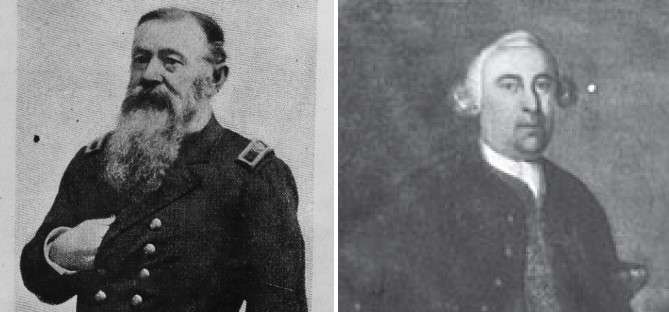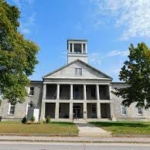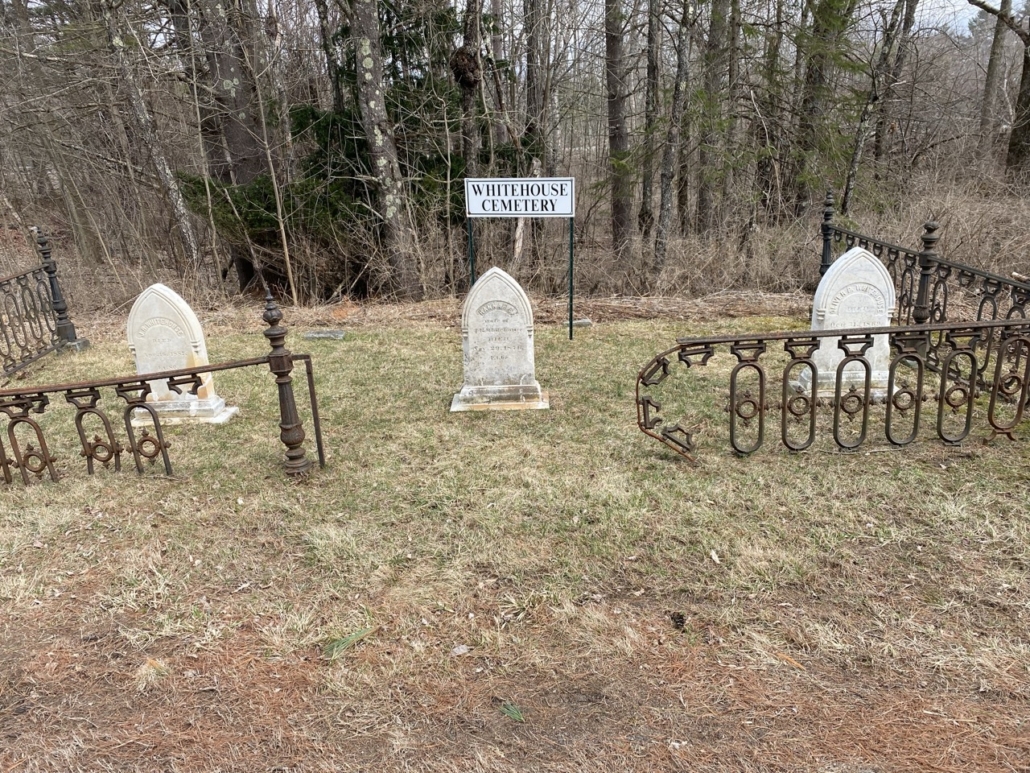Up and down the Kennebec Valley: Early Augusta Families – Part 1
by Mary Grow
The three people whose diaries Charles Nash excerpted in his 1904 Augusta history, and who provided old weather records for last week’s article, were members of some of the first families to settle in the area.
Martha Ballard came to Hallowell in October 1777, two years after her husband Ephraim brought his surveying business to the area. Henry Sewall came “after the Revolution,” Daniel Cony in 1778.
An even earlier arrival was Captain James Howard, Fort Western’s first commander in 1754, who, historian James North said, “may be considered the first settler at Cushnoc.”
The Ballard, Cony, Howard and Sewall families were all large. They were mutually acquainted, sometimes intermarried. Martha’s diary is filled with accounts of delivering babies and attending funerals of members of all four families. No doubt the interactions that have survived in the historical record are only a small part of their neighborly and familial relations.
This week’s article is about the Howards. Next week or weeks, Ballards, Sewalls and Conys. When readers find the Howard family confusing, please do not blame your writer; blame them for re-using the same names – especially Samuel – in each generation.
* * * * * *
James North wrote in his 1870 Augusta history that James Howard (1702 – May 14, 1787) was one of a group of Scotch Protestants who came to Boston and then settled, in April 1735, on the St. George River, east of the Kennebec.
The settlement dissolved in 1745, when most of the men joined the expedition that captured Louisbourg, the French fort on Cape Breton Island, during King George’s War (1744-1748). North wrote that Howard came back to the St. George’s settlement in 1749; in 1754, Massachusetts Governor William Shirley put him in charge of newly-built Fort Western.
Another of the St. George settlers was James’ brother, Lieutenant Samuel Howard, who also moved to the Kennebec in 1754 and served under Captain William Lithgow at Fort Halifax. Lithgow’s sister Margaret became his wife, and after the French and Indian wars ended they moved downriver to Cushnoc, where he died April 22, 1785, at the age of 84.
James Howard’s first wife Mary and their children came to Fort Western with him. Most sources list the children as John (1733 – July 30, 1804), Samuel (died March 29, 1799), William (1740 – April 7, 1810), and Margaret (Oct. 25, 1738 – March 21, 1806). (The on-line Fort Western history lists a James Jr. who was with his father in 1754.)
Mary Howard died Aug. 22, 1778. On Jan. 1, 1781, James Howard married Susanna Cony, “widow of Lieut. Samuel Cony.” She was born Dec. 22, 1747, and was thrice married and thrice widowed (her third husband, William Brooks, whom she married in 1788, died in 1824) before her death Aug. 5, 1830.
North said James and Susanna Howard had two children, a daughter who “died in childhood” and a son, James who died at 24.
James Howard became “the most influential man in the settlement,” and “the most prominent in this region of country,” North wrote. He and sons William and Samuel were “looked upon as fathers and benefactors of the new settlement, and they had the confidence of every one. Their will was law.”
One of Howard’s benefactions, according to Captain Charles Nash’s chapter on Augusta in Henry Kingsbury’s Kennebec County history, was a sawmill he built in 1769 on a sizeable brook about a mile north of the fort. Promptly named Howard’s Brook, by 1890 it was Riggs’ Brook (a contemporary Google map shows Riggs Branch, a stream passing under Route 201 north of the Route 3 intersection to join the Kennebec.
The three Howards monopolized water-born trade, especially in lumber. James’ ship, under Samuel’s command, was the only one operating upriver from the coastal settlement at Georgetown.
North wrote that after a few years, James Howard left “the mercantile business” to his sons and started buying land. He bought two lots on the east shore of the river in 1763 and in 1770 built a “great house” on one.
General Benedict Arnold, stopping on his way to Québec in September 1775, stayed at the house for a week. North quoted expedition surgeon Dr. Isaac Senter on the Howards: “an exceeding hospitable, opulent, polite family.”
The fort kept a small garrison until 1767, “to maintain an English presence on the Kennebec River,” an on-line site says. After the military no longer needed it, Howard bought the 900-acre fort lot and buildings in 1769, for $500; he added 1,280 acres behind the fort land in 1771.
Howard and his sons turned the fort buildings into a trading post and living quarters, remodeling the north part of the barracks into four-room living areas downstairs and upstairs. On-line sites say William and his wife Martha moved there about 1770 and John not long afterwards. Brother Samuel joined them in 1774; an aunt and a cousin in 1785; and before his death their father James, who remodeled the south end of the building.
For years James Howard was the only justice of the peace between Pownalborough and Fort Halifax (Winslow). In this capacity he performed marriages, including his daughter Margaret’s to Captain James Patterson on Feb. 8, 1763. He was supposed to build a house on each of the two lots he purchased that year, but was excused from building on the second when he agreed instead not to charge the Plymouth Company any legal fees for two years.
The April 26, 1771, Massachusetts legislative act incorporating Hallowell empowered “James Howard, Esq.” “to issue his warrant for the purpose of calling the first meeting of the inhabitants,” North wrote. Howard did so, and at the meeting at Fort Western on May 22, 1771, he was elected one of three selectmen and the town treasurer (keeping the treasurer’s job nine years, North wrote). Nash wrote that about 30 voters attended.
Howard was also supposed to buy a town record book, at town expense. North said he apparently didn’t; Hallowell acquired its first record book when Daniel Cony was elected town clerk in 1785.
By the outbreak of the Revolution in April 1775, anti-British committees of correspondence were active along the Kennebec. On May 1, Hallowell sent Howard to Pownalborough to meet with other towns’ committee members, discuss action and “get provision and ammunition.” North wrote that he was given “unlimited authority” to act on the town’s behalf. He and his son Samuel were on the five-member committee of vigilance that was empowered to investigate local “disorders, etc.”
In April 1777 James Howard was chosen Hallowell’s delegate to a county convention at Wiscasset, about which North gave few details.
By September 1777, he was one of nine justices on the Court of General Sessions of the Peace, which North explained was composed of Lincoln County’s justices of the peace. It had grand and petit juries, and criminal jurisdiction; notable cases at that time were against people accused of being Tories (one was “Mr. Ballard of Vassalborough,” surely Martha’s husband Ephraim).
North recorded that the Dec. 16, 1777, court session had to be canceled because Howard, on his way from Fort Western to the courthouse at Pownalborough, fell on the ice and was too seriously hurt to continue, and no substitute was available.
In 1784, North wrote, Howard was appointed one of three (later four) judges on Lincoln County’s Court of Common Pleas, a position he held until his death.
Beginning in 1787, sessions of both courts were authorized in Hallowell. North wrote that the first Court of Common Pleas term began on the second Tuesday in January (Jan. 9), 1787 “at the Fort Western settlement” “in Pollard’s tavern.” The judges were James Howard, William Lithgow and Nathaniel Thwing.
In the summer of 1785, Howard was one of a three-man committee – the other two were Ephraim Ballard, then a Hallowell selectman, and Joseph North, an ancestor of historian James North – sent to join similar committees from nearby towns to petition the Massachusetts General Court to hold a Supreme Judicial Court term in Lincoln County.
When James Howard died on May 14, 1787, Joseph North was appointed his successor on the Court of Common Pleas.
James North added a footnote in his history: Howard’s death was noted in Henry Sewall’s diary.
* * * * * *
According to North, James Howard’s oldest son John was second in command at the fort during the wars with the French. In 1759 he made a 200-mile journey through the wilderness from Fort Western to deliver dispatches to General James Wolfe at the siege of Québec. (North did not say whether he traveled alone.)
A second journey north in 1761 had a disastrous outcome for the young man. His father took him on a government-sponsored expedition to Canada intended to investigate possibilities of expanding trade with the native inhabitants. John shot at when he thought was a bear in the brush and accidentally killed another of the men. Although no one blamed him, “the occurrence so affected him that he sank into hopeless insanity.”
North described Captain Samuel Howard as “a master mariner” and a business partner with his brother William; they formed S. & W. Howard. “Samuel purchased goods in Boston and William sold them at the fort and furnished freight for the vessel which Samuel run,” North wrote.
When the new United States started building a navy during the Revolution, Samuel Howard brought masts and spars from the Kennebec. North described one load: “forty-eight masts, fourteen bowsprits, twenty-seven anchor stocks, and four thousand two hundred and ninety-nine inches of spars of various sizes.” Some of the masts were too big for Howard’s ship and had to be towed to Boston.
Samuel’s wife was Sarah Lithgow, the daughter of William Lithgow at Fort Halifax (whose sister Margaret had married Samuel’s uncle Samuel). They had two sons, William and Robert, to carry on the Howard name, and a daughter Sarah, who became Mrs. Thomas Bowman.
Colonel William Howard was, in 1759, a 19-year-old lieutenant at Fort Halifax, under Lithgow’s command. In addition to his business in partnership with his brother, he held various civic posts, including being elected on July 10, 1775, as Hallowell’s first – and until 1785 only – representative “in the General Court organized in 1775 under the revolutionary government.”
His title originated during the Revolution, when, North said, he was a lieutenant-colonel of militia; later he was a colonel in the (Massachusetts) state militia. He served on at least one town committee intended to keep an eye on Tories, and was involved in transporting Maine recruits to the army around Boston; North quoted a 1777 payment of almost four (British) pounds “for mileage of soldiers to Cambridge.”
Later, North wrote, he “was occasionally a selectman, and succeeded his father as [Hallowell] treasurer in 1780, an office which he held for twenty-one consecutive years.”
Colonel William married his cousin, fort commander James’ brother Samuel’s daughter Martha, in 1768 or 1769. She died Oct. 28, 1785. Of their five children, only yet another Samuel, “known as Col. Samuel,” and Mary, who married the rector of Trinity Church, in Boston, lived to adulthood, North said.
Other Howard family monuments
In addition to the reconstructed Fort Western, Augusta has two other monuments to the Howard family: Howard Street, which parallels the east bank of the Kennebec south of Fort Western; and the 164-acre Howard Hill Conservation Area west of the State House complex.
An on-line Land for Maine’s Future site gives a summary history of the conservation area, beginning in the late 1700s, when Colonel Samuel Howard acquired the southern part of Howard Hill on the west side of the Kennebec.
In the 1890s, “William Howard Gannett and his wife, Sarah Neil Hill Gannett, reside on 500 acres with extensive gardens on ‘Betsy Howard Hill’.”
The area was a state game preserve for much of the 20th century and into the 21st. In 2009, the Kennebec Land Trust and Augusta city officials started “actively pursuing conservation options for 164 acres on Howard Hill.”
Since 2017, the property has belonged to Augusta, with KLT holding a conservation easement. It presently offers three miles of trails and is described as including old carriage roads, “a cascading stream, steep ravines, large boulders, an expansive ridgeline with sheer cliffs, and diverse wildlife habitat.”
Main sources
Kingsbury, Henry D., ed., Illustrated History of Kennebec County Maine 1625-1892 (1892).
Nash, Charles Elventon, The History of Augusta (1904).
North, James W., The History of Augusta (1870).
Websites, miscellaneous.
Responsible journalism is hard work!
It is also expensive!
If you enjoy reading The Town Line and the good news we bring you each week, would you consider a donation to help us continue the work we’re doing?
The Town Line is a 501(c)(3) nonprofit private foundation, and all donations are tax deductible under the Internal Revenue Service code.
To help, please visit our online donation page or mail a check payable to The Town Line, PO Box 89, South China, ME 04358. Your contribution is appreciated!







Leave a Reply
Want to join the discussion?Feel free to contribute!